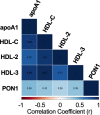HDL-3 is a superior predictor of carotid artery disease in a case-control cohort of 1725 participants
- PMID: 24965026
- PMCID: PMC4309059
- DOI: 10.1161/JAHA.114.000902
HDL-3 is a superior predictor of carotid artery disease in a case-control cohort of 1725 participants
Abstract
Background: Recent data suggest that high-density lipoprotein cholesterol (HDL-C) levels are likely not in the causative pathway of atheroprotection, shifting focus from HDL-C to its subfractions and associated proteins. This study's goal was to determine which HDL phenotype was the better predictor of carotid artery disease (CAAD).
Methods and results: HDL-2 and HDL-3 were measured in 1725 participants of European ancestry in a prevalent case-control cohort study of CAAD. Stratified analyses were conducted for men (n=1201) and women (n=524). Stepwise linear regression was used to determine whether HDL-C, HDL-2, HDL-3, or apolipoprotein A1 was the best predictor of CAAD, while adjusting for the confounders of censored age, diabetes, and current smoking status. In both men and women, HDL-3 was negatively associated with CAAD (P=0.0011 and 0.033 for men and women, respectively); once HDL-3 was included in the model, no other HDL phenotype was significantly associated with CAAD. Addition of paraoxonase 1 activity to the aforementioned regression model showed a significant and independent (of HDL-3) association with CAAD in men (P=0.001) but not in the smaller female subgroup.
Conclusions: This study is the first to contrast the associations of HDL-2 and HDL-3 with CAAD. We found that HDL-3 levels were more predictive of CAAD status than HDL-2, HDL-C, or apolipoprotein A1. In addition, for men, paraoxonase 1 activity improved the overall model prediction for CAAD independently and additively with HDL-3 levels. Further investigation into the molecular mechanisms through which HDL-3 is associated with protection from CAAD is warranted.
Keywords: atherosclerosis; carotid arteries; high‐density lipoprotein; lipids; lipoproteins.
© 2014 The Authors. Published on behalf of the American Heart Association, Inc., by Wiley Blackwell.
Figures
References
-
- Go AS, Mozaffarian D, Roger VL, Benjamin EJ, Berry JD, Blaha MJ, Dai S, Ford ES, Fox CS, Franco S, Fullerton HJ, Gillespie C, Hailpern SM, Heit JA, Howard VJ, Huffman MD, Judd SE, Kissela BM, Kittner SJ, Lackland DT, Lichtman JH, Lisabeth LD, Mackey RH, Magid DJ, Marcus GM, Marelli A, Matchar DB, McGuire DK, Mohler ER, Moy CS, Mussolino ME, Neumar RW, Nichol G, Pandey DK, Paynter NP, Reeves MJ, Sorlie PD, Stein J, Towfighi A, Turan TN, Virani SS, Wong ND, Woo D, Turner MBon behalf of the American Heart Association Statistics Committee and Stroke Statistics Subcommittee. Heart disease and stroke statistics–2014 update: a report from the American Heart Association. Circulation. 2014; 129:e28-e292. - PMC - PubMed
-
- Lozano R, Naghavi M, Foreman K, Lim S, Shibuya K, Aboyans V, Abraham J, Adair T, Aggarwal R, Ahn SY, Alvarado M, Anderson HR, Anderson LM, Andrews KG, Atkinson C, Baddour LM, Barker‐Collo S, Bartels DH, Bell ML, Benjamin EJ, Bennett D, Bhalla K, Bikbov B, Bin Abdulhak A, Birbeck G, Blyth F, Bolliger I, Boufous S, Bucello C, Burch M, Burney P, Carapetis J, Chen H, Chou D, Chugh SS, Coffeng LE, Colan SD, Colquhoun S, Colson KE, Condon J, Connor MD, Cooper LT, Corriere M, Cortinovis M, de Vaccaro KC, Couser W, Cowie BC, Criqui MH, Cross M, Dabhadkar KC, Dahodwala N, De Leo D, Degenhardt L, Delossantos A, Denenberg J, Jarlais Des DC, Dharmaratne SD, Dorsey ER, Driscoll T, Duber H, Ebel B, Erwin PJ, Espindola P, Ezzati M, Feigin V, Flaxman AD, Forouzanfar MH, Fowkes FGR, Franklin R, Fransen M, Freeman MK, Gabriel SE, Gakidou E, Gaspari F, Gillum RF, Gonzalez‐Medina D, Halasa YA, Haring D, Harrison JE, Havmoeller R, Hay RJ, Hoen B, Hotez PJ, Hoy D, Jacobsen KH, James SL, Jasrasaria R, Jayaraman S, Johns N, Karthikeyan G, Kassebaum N, Keren A, Khoo J‐P, Knowlton LM, Kobusingye O, Koranteng A, Krishnamurthi R, Lipnick M. Global and regional mortality from 235 causes of death for 20 age groups in 1990 and 2010: a systematic analysis for the Global Burden of Disease Study 2010. Lancet. 1990; 380:2095-2128. - PMC - PubMed
-
- ECST. MRC European Carotid Surgery Trial: interim results for symptomatic patients with severe (70‐99%) or with mild (0‐29%) carotid stenosis. European Carotid Surgery Trialists' Collaborative Group. Lancet. 1991; 337:1235-1243. - PubMed
-
- ECST. Endarterectomy for moderate symptomatic carotid stenosis: interim results from the MRC European Carotid Surgery Trial. Lancet. 1996; 347:1591-1593. - PubMed
-
- North American Symptomatic Carotid Endarterectomy Trial Collaborators. Beneficial effect of carotid endarterectomy in symptomatic patients with high‐grade carotid stenosis. N Engl J Med. 1991; 325:445-453. - PubMed
Publication types
MeSH terms
Substances
Grants and funding
LinkOut - more resources
Full Text Sources
Other Literature Sources
Medical


